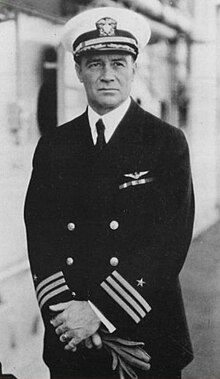Kenneth Whiting
| Kenneth Whiting | |
|---|---|

Commander Kenneth Whiting aboard the aircraft carrier USS Saratoga (CV-3) during his 1927–1929 tour as her executive officer.
|
|
| Born |
22 July 1881 , Massachusetts |
| Died | 24 April 1943 (aged 61) Bethesda, Maryland |
| Buried at | sea off Execution Rocks in Long Island Sound |
| Allegiance | United States of America |
| Service/branch | United States Navy |
| Years of service | 1905–1943 |
| Rank | Captain |
| Commands held | |
| Battles/wars | |
| Awards | |
Kenneth Whiting (22 July 1881 – 24 April 1943) was a United States Navy officer who was a pioneer in submarines and is best known for his lengthy career as a pioneering naval aviator. During World War I, he commanded the first American military force to arrive in Europe for combat. After the war, he was instrumental in development of the aircraft carrier in the United States, where he sometimes is known as the U.S. Navy's "father of the aircraft carrier." He was involved in some way in the design or construction of five of the first six U.S. Navy aircraft carriers, and served as acting commanding officer of the first carrier to enter U.S. Navy service and as executive officer of the first two American carriers. In the earliest days of the U.S. Navy's development of an aircraft carrier force, he led many shipboard innovations still in use aboard carriers today.
Whiting was born in , Massachusetts, on 22 July 1881, but moved to Larchmont, New York, at an early age. Larchmont remained his residence for the rest of his life. He was appointed as a Naval Cadet on 7 September 1900 and became a midshipman from New York at the United States Naval Academy in Annapolis, Maryland, in 1901. After graduating from the Naval Academy on 30 January 1905, he reported aboard the armored cruiser USS West Virginia. After serving the requisite sea duty, he was commissioned as an ensign on either 31 January 1907 or 25 February 1908, according to different sources.
...
Wikipedia
